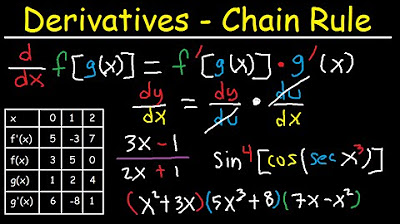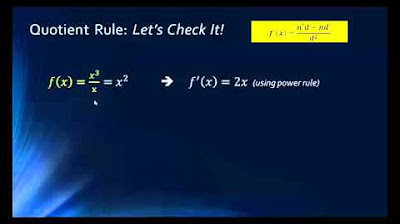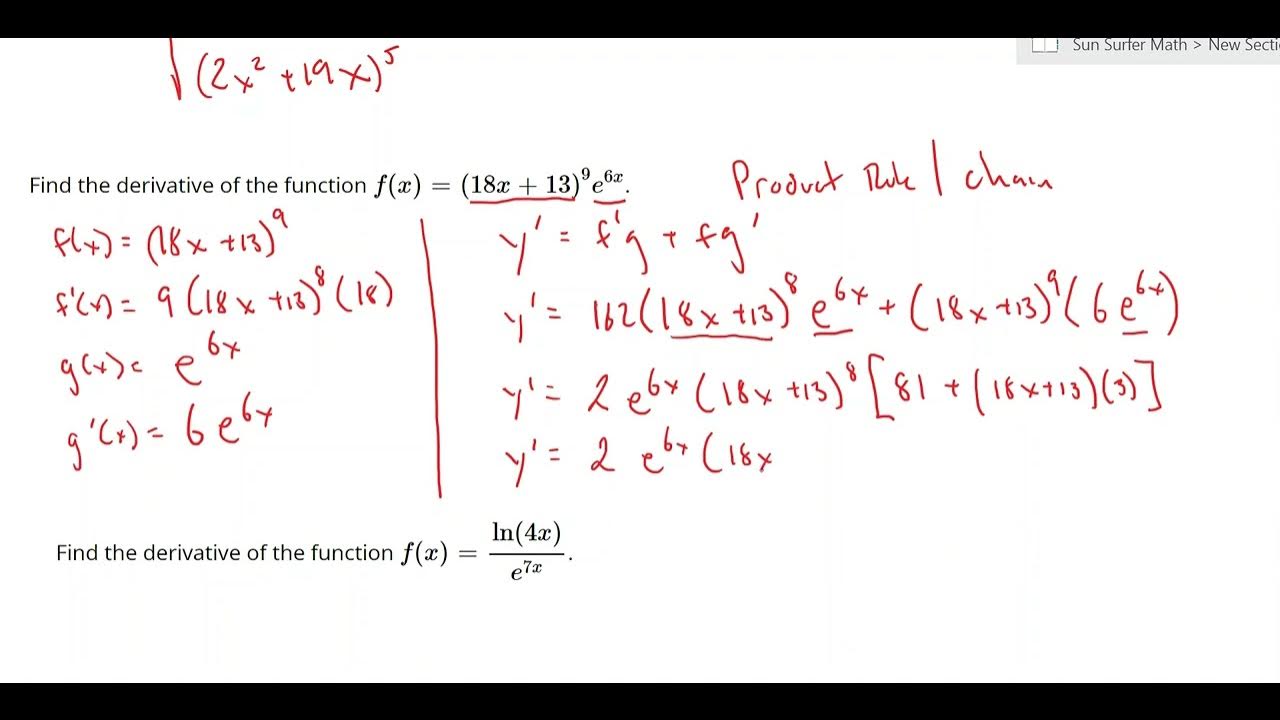The Quotient Rule for Derivatives — Topic 58 of Machine Learning Foundations
TLDRThe video script introduces the quotient rule, a fundamental concept in calculus, which is closely related to the product rule. It explains that when differentiating a fraction where two variables are divided by each other, the quotient rule is applied. The formula for the quotient rule is presented, highlighting its similarity to the product rule but with a minus sign and an additional denominator term. The script then illustrates the application of the quotient rule with a numerical example, showing how to differentiate y = (4x^2) / (x^3 + 1) by breaking it down into two separate variables, calculating their derivatives, and then applying the quotient rule formula. The example concludes with the simplified derivative result of -4x^4. The script concludes by mentioning the chain rule, another important derivative rule, which is particularly useful in the field of machine learning.
Takeaways
- 📚 The quotient rule is similar to the product rule, but it applies to division of two variables.
- 🔢 The formula for the quotient rule is dw/dx * z - w * dz/dx, all divided by z^2.
- ↔️ The numerator of the quotient rule resembles the product rule, but with a subtraction and includes the denominator.
- 📈 The quotient rule is useful in situations where variables are divided by each other, just like the product rule.
- 🌰 An example provided is y = (4x^2) / (x^3 + 1), which can be broken down into w = 4x^2 and z = x^3 + 1.
- 🧮 Calculating the derivatives of w and z separately simplifies the application of the quotient rule.
- ⚖️ The derivative of w (dw/dx) is 8x, and for z (dz/dx), it is 3x^2 after considering the power rule.
- 🛠️ To find the derivative of y, plug the values of w, dw/dx, z, and dz/dx into the quotient rule formula.
- 📉 The constant term in the denominator z does not contribute to the derivative and can be ignored.
- ➗ Simplifying the equation involves multiplying terms within the numerator and denominator and then performing arithmetic operations.
- 🔑 The final simplified derivative of the example given is -4x^4.
- 🔗 The chain rule is introduced as the next topic, which is crucial for machine learning applications.
Q & A
What is the quotient rule in calculus?
-The quotient rule is a method for finding the derivative of a function that is the ratio of two other functions. It is similar to the product rule, but instead of multiplying variables, it involves dividing them.
How does the quotient rule formula look like?
-The quotient rule formula is expressed as dw/dx * z - w * dz/dx, all divided by z^2, where w and z are the numerator and denominator functions, respectively.
What is the difference between the product rule and the quotient rule?
-The product rule is used for multiplying two functions, and it involves adding the derivative of the first function times the second function to the first function times the derivative of the second function. The quotient rule, on the other hand, is for dividing functions and involves subtracting the product of the numerator function and the derivative of the denominator function from the product of the derivative of the numerator function and the denominator function, all divided by the square of the denominator function.
What is the power rule in calculus?
-The power rule states that if you have a function of the form f(x) = x^n, where n is a constant, its derivative is f'(x) = n * x^(n-1).
How is the constant multiple rule applied in calculus?
-The constant multiple rule states that the derivative of a constant times a function is the constant times the derivative of the function. In other words, if c is a constant and f(x) is a function, then the derivative of cf(x) is c * f'(x).
What is the process of calculating the derivative of y = 4x^2 / (x^3 + 1) using the quotient rule?
-First, you identify w as 4x^2 and z as x^3 + 1. Then, you find the derivatives dw/dx = 8x and dz/dx = 3x^2. You apply the quotient rule formula, plug in the values, and simplify to get the final derivative.
How do you simplify the expression obtained after applying the quotient rule to y = 4x^2 / (x^3 + 1)?
-You multiply the terms in the numerator and the denominator, combine like terms, and perform arithmetic operations to simplify the expression. The final simplified form is -4x^4.
What is the chain rule in calculus?
-The chain rule is a method for finding the derivative of a composition of functions. It states that the derivative of a composite function is the derivative of the outer function evaluated at the inner function, times the derivative of the inner function.
Why is the chain rule considered useful in machine learning?
-The chain rule is fundamental in machine learning as it is used for backpropagation, which is a technique for efficiently computing gradients in neural networks. It allows for the calculation of the gradient of the loss function with respect to the weights of the network.
What is the significance of the quotient rule in solving calculus problems?
-The quotient rule is significant because it allows for the differentiation of functions that are expressed as fractions, which is common in various mathematical, scientific, and engineering applications.
How does the denominator in the quotient rule affect the derivative calculation?
-The denominator, represented as z in the quotient rule formula, affects the derivative calculation by being squared and used as the denominator of the entire expression. It is crucial for ensuring the correct scaling of the derivative.
What is the role of the constant term in the derivative of z = x^3 + 1?
-The constant term (+1) in the function z = x^3 + 1 does not contribute to the derivative since the derivative of a constant is zero. Therefore, when calculating dz/dx, only the term x^3 is considered.
Can you provide an example of a function that would require the use of the quotient rule for differentiation?
-An example of a function that would require the quotient rule for differentiation is y = (3x^2) / (x^3 - 2), as it involves dividing two functions of x.
Outlines
🔢 Deriving the Quotient Rule
The paragraph begins by introducing the quotient rule, which is analogous to the product rule previously discussed. The focus is on dividing two variables rather than multiplying them. The quotient rule is expressed with a formula that includes the derivatives of the numerator (dw/dx) and the denominator (dz/dx), with the latter subtracted from the former, all divided by the square of the denominator (z^2). The rule is applicable in similar contexts as the product rule. An example is provided to illustrate the rule, where y is defined as four x squared over x cubed plus one. The derivatives of the numerator and denominator are calculated separately using the power rule and constant multiple rule, resulting in 8x and 3x squared, respectively. The quotient rule formula is then applied to find the derivative of y, which simplifies to -4x to the power of 4. The paragraph concludes by mentioning the next topic, the chain rule, which is crucial in machine learning.
Mindmap
Keywords
💡Quotient Rule
💡Product Rule
💡Derivative
💡Power Rule
💡Constant Multiple Rule
💡Numerator and Denominator
💡Chain Rule
💡Machine Learning
💡Arithmetic Addition and Subtraction
💡Like Terms
💡Simplified Form
Highlights
The quotient rule is similar to the product rule, but involves dividing two variables.
When differentiating a fraction, the quotient rule formula is used, which includes separate terms for the derivative of the numerator and denominator.
The numerator of the quotient rule formula resembles the product rule, with a plus sign and lacking a denominator.
The quotient rule is applicable in the same situations as the product rule, as previously covered.
An example is provided with y = 4x^2 / (x^3 + 1), which is split into separate variables w and z.
The derivatives of w (4x^2) and z (x^3 + 1) are calculated separately using the power rule and constant multiple rule.
The derivative of z has two terms, but the second term is a constant and thus becomes 0.
The derivative of y is calculated using the quotient rule formula by plugging in the values of dw/dx and dz/dx.
The denominator in the quotient rule is the square of z (x^3 + 1)^2.
Simplifying the equation involves multiplying within the terms and performing arithmetic operations on like terms.
The final answer for the derivative of y is -4x^4 after simplification.
An additional derivative rule, the chain rule, is mentioned as being particularly useful in machine learning.
The chain rule is the last derivative rule to be covered before moving on to more comprehensive exercises.
The power rule is applied to both w and z to find their respective derivatives.
The constant multiple rule is used in conjunction with the power rule to find the derivative of w.
The derivative of z is simplified by ignoring the constant term in the calculation.
The quotient rule formula is applied by substituting the calculated derivatives into the formula.
The arithmetic operations are performed to obtain the final simplified derivative of y.
The quotient rule is emphasized for its utility in calculus and its connection to the product rule.
Transcripts
Browse More Related Video

Quotient rule from product & chain rules | Derivative rules | AP Calculus AB | Khan Academy

The Quotient Rule

The Product Rule for Derivatives — Topic 57 of Machine Learning Foundations

Derivatives of Composite Functions - Chain Rule, Product & Quotient Rule

Math 1325 Lecture 9 5 - Product & Quotient Rule

The Chain Rule - More Examples
5.0 / 5 (0 votes)
Thanks for rating: